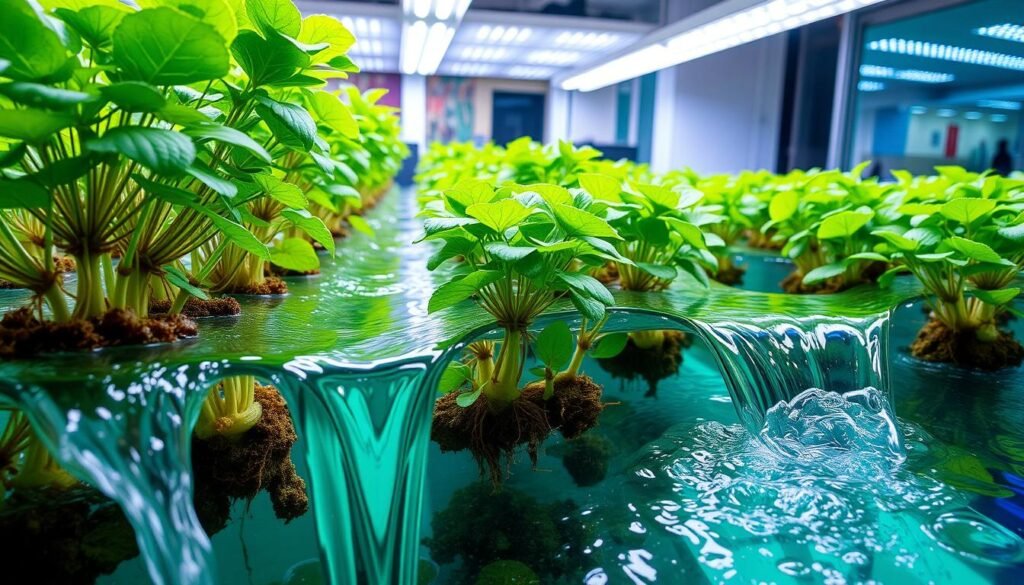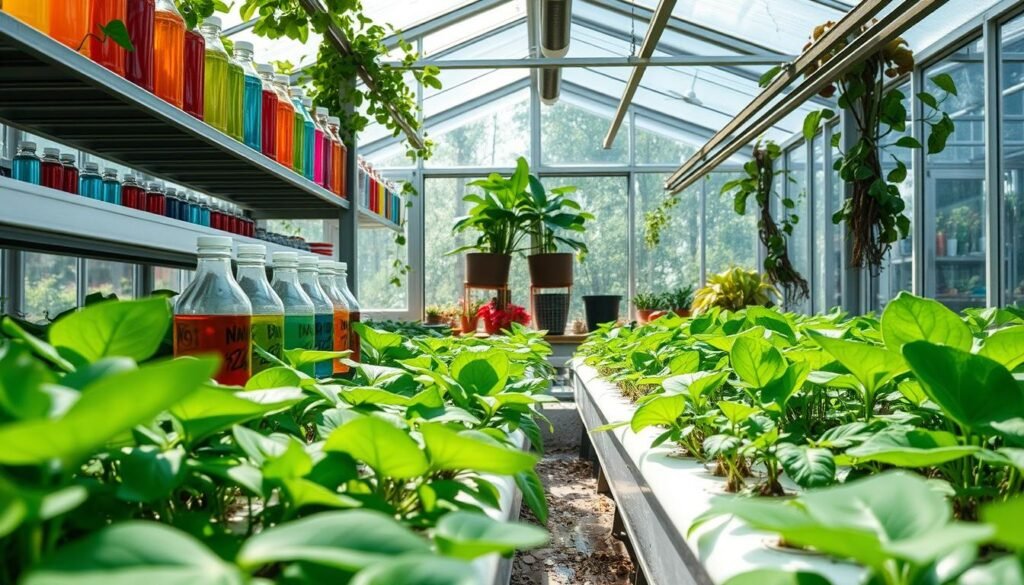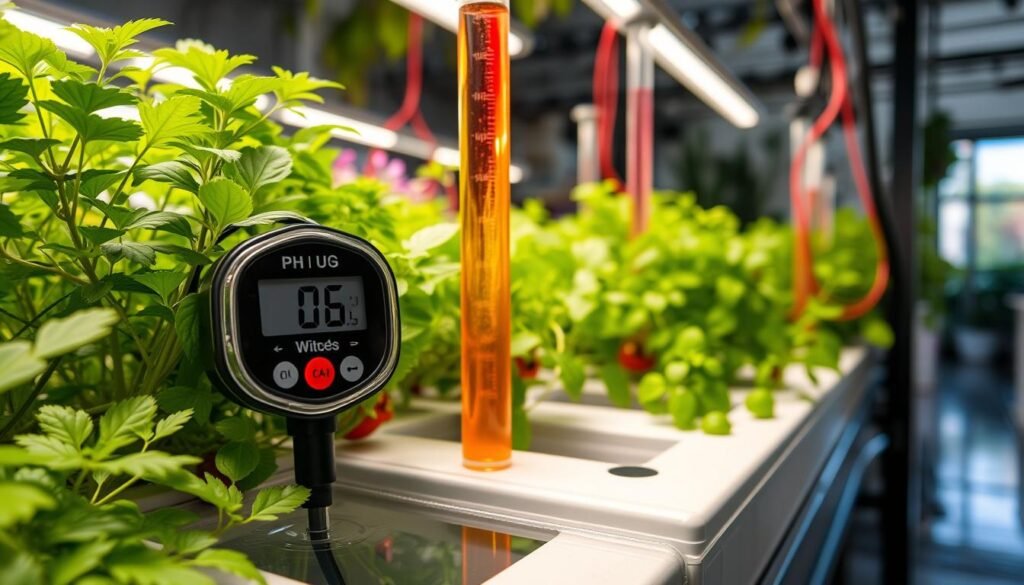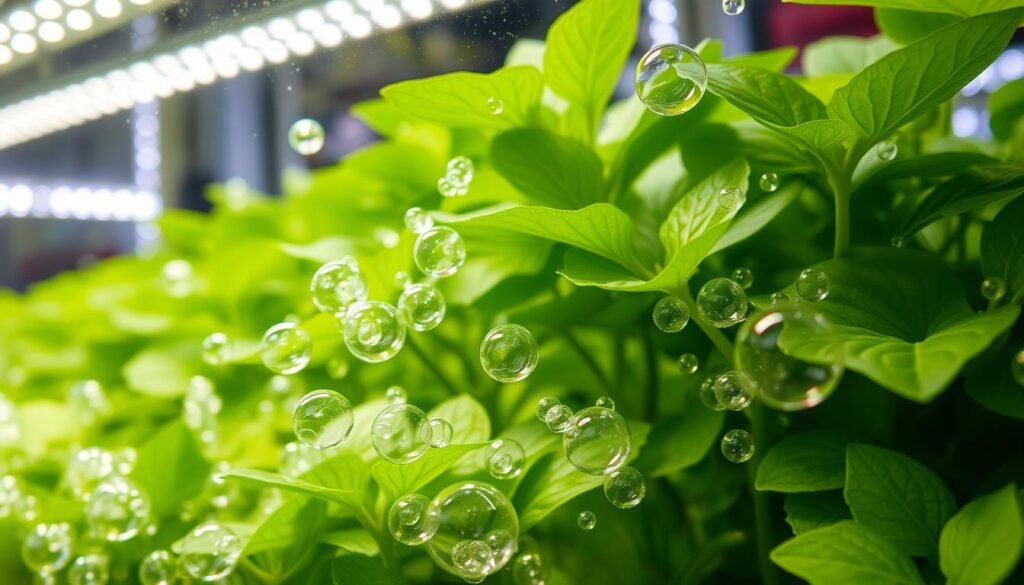Hydroponics water is key in efficient planting. It grows plants without soil, using nutrient-rich water for the roots. This guide will help you manage hydroponics water, like ensuring quality and picking the right nutrients. You’ll learn how to control pH levels too. With these tips, you can see faster growth and higher yields than soil-based systems.

Key Takeaways
- Hydroponics uses up to 95% less water than traditional agriculture.
- This method allows for faster growth rates, estimated at 30-50% compared to soil-grown plants.
- Understanding water quality is vital for achieving robust plant health.
- Common crops include herbs, leafy greens, strawberries, and tomatoes.
- Deep Water Culture (DWC) is widely used for small-scale hydroponic systems.
- Effective communication within the growing team is key for success.
Understanding Hydroponics and Its Benefits
Hydroponics is a new way to grow plants without soil. It has been around for over a century. It works well for small farmers, hobbyists, and big companies.
With hydroponics, you can grow many plants like herbs and tomatoes. There are different systems for growing plants. These systems were first used by German scientists in the late 19th century.
Hydroponics is good for saving water, using up to 90% less than regular farming. It’s great for places with bad soil or weather. Indoor systems use special water to make plants grow well.
Plants grown with hydroponics are healthier and taste better. NASA even uses it to grow plants in space. It’s a big step for farming on Earth and in space.
Importance of Hydroponics Water Quality
Water quality is key in hydroponics, affecting how plants absorb nutrients and their health. Since hydroponics rely on water, keeping it clean is crucial. Bad water quality can cause plants to lack nutrients or even get sick.
Knowing what makes water good or bad for plants is important. This knowledge helps keep your hydroponic garden healthy and thriving.
How Water Quality Affects Plant Health
The health of your plants depends on the water’s quality. Too much or too little electrical conductivity (EC) can mess with nutrient levels. For example, water from Reverse Osmosis (RO) systems has a low EC, while tap water can be higher.
Keeping the right amount of dissolved oxygen is also key. Levels between 7-10 parts per million (ppm) help plants grow well. Even higher levels, up to 20 ppm, can boost lettuce yield by 40%.

Common Water Contaminants and Their Impact
Knowing about common water pollutants helps keep your hydroponics water clean. Chlorine and chloramine in tap water can harm roots and slow growth. Using aeration or activated charcoal can remove these harmful substances.
Water hardness also matters, as it affects how plants take in nutrients. Very hard water needs a reverse osmosis system to purify. Being aware of these factors is crucial to protect your hydroponic garden.
Choosing the Right Nutrient Solution
Choosing the right nutrient solution is key for your hydroponic plants’ health and growth. A good nutrient solution has nitrogen, phosphorus, potassium, calcium, and magnesium. Knowing which nutrients to use and how to mix them helps your plants grow well in hydroponics.
Key Nutrients for Hydroponic Plants
The success of your hydroponic system depends on the right nutrients. Here are the main nutrients to focus on:
- Nitrogen (N): Important for leaf growth and plant strength.
- Phosphorus (P): Helps with root growth and flowering.
- Potassium (K): Improves fruit quality and fights disease.
- Calcium (Ca): Crucial for cell walls and nutrient absorption.
- Magnesium (Mg): Key for photosynthesis.
These nutrients help your plants grow strong and healthy. For plants like tomatoes, use specialized formulas. For example, Hydro-Gardens Chem-Gro tomato formula is a good choice. It has magnesium and micronutrients for strong plant health.
How to Properly Mix Nutrient Solutions
Mixing nutrients correctly is crucial for a good nutrient solution. Here’s how to do it:
- Start by measuring the water and nutrients you need.
- Follow the manufacturer’s instructions for nutrient levels.
- Mix powdered nutrients well to avoid clumps.
- Check how well fertilizers dissolve in water. Some dissolve better in cold or hot water.
- Use EC meters to check nutrient levels and adjust as needed.
The nutrient solution’s strength depends on the plant type and growth stage. Brands like Canna and Plant Magic have products for different needs. Follow the application guidelines to avoid underfeeding or toxicity, which can harm growth.

Managing pH Levels for Optimal Growth
Keeping the right pH levels is key for hydroponics success. It affects how plants get nutrients, which is crucial for their health and growth. Knowing the pH scale, from 0 to 14, helps you see if your solution is too acidic or basic. A pH of 7 is neutral, and levels below or above it are acidic or basic, respectively.
For hydroponic plants, the best pH range is between 5.5 and 6.5. This range helps them absorb nutrients well.
Understanding pH and Its Role in Hydroponics
Every plant needs a specific pH level. For instance, hydroponic tomatoes do best at a pH of 6.0 when they’re growing. But, they need a pH of about 5.5 when they’re producing fruit. This change helps them get the nutrients they need, like Potassium and Iron.
Also, materials like rockwool can have a higher pH. Soaking them in pH 5.5 water is needed to lower it. It’s important to check and adjust the pH regularly to keep it in the right range.
How to Test and Adjust pH Levels
Testing pH is a must in hydroponics. You can use pH meters, litmus test strips, or liquid pH test kits. Meters are accurate but need calibration often. It’s good to check your nutrient solution weekly, especially after mixing or adding more water.
If you need to adjust the pH, remember that alkaline water can raise it. You might need to use an acidic solution to lower it.

Keeping pH levels balanced helps plants absorb nutrients better. It also prevents harm from too much salt in the solution. Regular checks and adjustments can make your hydroponics system thrive, leading to healthy plants and plenty of harvests.
Maintaining Optimal Oxygen Levels in Hydroponics Water
Oxygen is key for plant health in hydroponics. It helps roots grow strong, which is important for getting nutrients and growing well. Keeping oxygen levels right is crucial for a hydroponics system to work well.
The Role of Oxygen in Plant Health
Plants need enough oxygen to live and grow. Good root systems help them take in water and nutrients. If oxygen levels fall below 5 ppm, plants start to stress out.
Levels below 2 ppm for a long time can be deadly for plants. Healthy hydroponics water should have 7-12 ppm oxygen. This helps plants grow strong and keeps diseases like root rot away.
Methods to Increase Oxygen Levels Effectively
There are ways to boost oxygen in hydroponics water for better plant health:
- Use air stones and air compressors for aeration.
- Set up cycle timer controllers for oxygenation.
- Choose growing media that lets air through.
- Boost water circulation with pumps for better oxygen spread.
- Use hydrogen peroxide to raise dissolved oxygen levels.
- Add more plants to increase oxygen in the system.
Temperature affects how much oxygen water can hold. Warmer water holds less oxygen than cooler water. So, it’s important to keep an eye on temperature. Using these methods helps keep oxygen levels right for healthy plants in your hydroponics system.

Water Temperature and Its Effects on Hydroponics
Knowing how water temperature affects plant health is key in hydroponics. The best water temperature is between 18 to 25 degrees Celsius (65 to 77 degrees Fahrenheit). Keeping this range helps plants absorb nutrients better and grow strong.
Each hydroponic system has its own temperature needs. Learning these can make your gardening better.
Ideal Water Temperatures for Different Plants
Every hydroponic system needs the right temperature. For instance:
- Aeroponics: Best kept between 20–27 degrees Celsius (68–81 degrees Fahrenheit)
- Aquaponics: Ideal at 20–28 degrees Celsius (68–82 degrees Fahrenheit)
- Drip Irrigation: Optimal at 23–26 degrees Celsius (73.4 ± 2.1 degrees Fahrenheit)
- Ebb and Flow Irrigation: Should be around 22 ± 0.5 degrees Celsius (71.6 ± 1.1 degrees Fahrenheit)
Keeping temperatures in these ranges helps avoid root rot. Root rot can really hurt plant yields.
How Temperature Influences Nutrient Absorption
Water temperature affects how plants absorb nutrients. Warmer water makes nutrients dissolve better, helping plants take them in. But, water over 25 degrees Celsius (77 degrees Fahrenheit) can cause root rot.
Root rot harms plant health and growth. Keeping water at 20 degrees Celsius (68 degrees Fahrenheit) is important for good nutrient absorption.
To control water temperature, use insulation and cooling fans. Also, getting a hydroponic water chiller helps manage temperature spikes. This keeps your plants healthy.
Types of Hydroponics Systems and Water Usage
Knowing about different hydroponics systems is key to saving water and growing healthy plants. Each system has its own way of giving nutrients to plants and uses varying amounts of water. This affects how well the system works and how healthy the plants are. Here’s a look at common hydroponics systems and how much water they need.
Overview of Common Hydroponics Systems
- Wick System: The simplest setup that does not require electricity, ideal for small garden plants and herbs.
- Deep Water Culture (DWC): Accessible for nearly all plants, especially those with large root systems, offering effective water usage.
- Ebb and Flow: Popular for home gardeners; suitable for various plant types including root vegetables, though it may face pump malfunctions.
- Nutrient Film Technique (NFT): Utilizes sloped channels for nutrient delivery, best suited for plants with smaller roots and emphasizes efficient water usage.
- Drip System: Adjustable flow rates make it suitable for numerous plant types, offering flexibility in water usage management.
- Aeroponic System: Supports any plant with the right mist nozzle setup, promoting efficient water usage through aerosols.
Water Needs for Different Hydroponic Setups
Each hydroponics system needs a different amount of water. This affects how much you need to maintain the system and how fast plants grow:
| Hydroponics System | Water Requirement | Best For |
|---|---|---|
| Wick System | Low, does not require pumps | Small plants and herbs |
| Deep Water Culture (DWC) | Moderate, direct access to nutrients | Large root systems and fruiting plants |
| Ebb and Flow | Moderate, relies on pump operation | Most plant types including root vegetables |
| Nutrient Film Technique (NFT) | Low to moderate, continuous flow of nutrients | Plants with smaller roots |
| Drip System | Adjustable, suitable for modifications | Various plant types |
| Aeroponic System | Very low, utilizes misting | Any plant with proper setup |
Choosing the right hydroponics system depends on your plants, space, and water management preferences. Knowing about these systems helps you grow thriving plants anywhere.
Effective Water Recycling Techniques
Water recycling is key to making hydroponics more sustainable. It helps growers use resources better. This method saves water and makes plants healthier by removing harmful substances from the water. Here are some effective ways to recycle water in hydroponics and their benefits.
Methods to Recycle Water in Hydroponics
Using efficient water recycling methods can greatly improve your hydroponic system. Some common techniques include:
- Reservoir Systems: Closed-loop systems collect and reuse water, cutting down on waste.
- Rainwater Harvesting: Storing rainwater for hydroponic use improves water management.
- Pasteurization: Heating water to high temperatures kills off harmful bacteria and germs.
- Ozone Sterilization: Ozone effectively kills off harmful microorganisms that can harm plant roots.
- UV Disinfection: UV-C radiation treats water without chemicals, keeping nutrients intact.
Benefits of Water Recycling for Sustainability
Water recycling in hydroponics shows a commitment to the environment. It also brings many benefits:
- Cost Savings: Using less freshwater reduces costs.
- Environmental Protection: It reduces wastewater discharge, helping the environment.
- Resource Efficiency: It makes water and nutrient use more efficient, improving crop quality and yield.
By using these water recycling techniques, you help make hydroponics more sustainable. This benefits the environment and your farming results. Such practices can solve the problems faced by traditional farming and wastewater management.
| Method | Benefits |
|---|---|
| Reservoir Systems | Minimizes water waste and enables efficient reuse. |
| Rainwater Harvesting | Provides an independent water source and reduces bills. |
| Pasteurization | Eliminates harmful microorganisms without chemical additives. |
| Ozone Sterilization | Effectively disinfects water for healthier plants. |
| UV Disinfection | Maintains nutrient levels while reducing pathogens. |
Environmental Factors Affecting Hydroponics Water
When you’re into hydroponics, you need to watch out for several environmental factors. These include humidity and light effects. Knowing about these can help you create a great growing space for your plants.
The Connection Between Humidity and Water Needs
Humidity is key in how much water your plants take in. Too much humidity can lead to plants getting too much water, causing problems. On the other hand, not enough humidity means plants drink more water to stay moist.
By keeping an eye on humidity, you can make your plants grow better. This also helps you use water wisely.
Effects of Light on Water Consumption
Light also affects how much water plants need. Without enough light, plants grow slowly and drink more water. They try to get energy by growing taller.
Having the right light in your hydroponic setup is important. It helps plants grow well and use water efficiently. By adjusting light, you can save water and help your plants thrive.



Pingback: Bottle Brush Plant: A Stunning Red Flowering Shrub
Pingback: Growing Shrimp Plant: Care Tips for Vibrant Blooms
Pingback: Growing Peperomia Plants: A Complete Care Guide | CropTap
Pingback: Growing Butterwort Plant: Complete Care Guide
Pingback: Complete Guide to Asphalt Plant Operations and Equipment
Pingback: Plant Fertilizer: Essential Guide for Home Gardeners
Pingback: Best Butterfly Plants to Attract These Amazing Pollinators
Pingback: Create Your Indoor Paradise with Tropical Plants
Pingback: Creative Cactus Garden Ideas for Your Desert Oasis
Pingback: Garden Pond Backsplash Ideas: Transform Your Water Feature